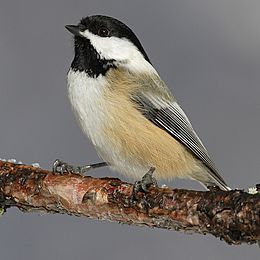Black-capped chickadee facts for kids
Quick facts for kids Black-capped chickadee |
|
|---|---|
 |
|
| Conservation status | |
| Scientific classification | |
| Kingdom: | |
| Phylum: | |
| Class: | |
| Order: | |
| Family: | |
| Genus: |
Poecile
|
| Binomial name | |
| Poecile atricapillus Linnaeus 1766
|
|
The black-capped chickadee (Poecile atricapillus) is a small, cheerful songbird. It belongs to the tit family and is known for its simple, clear song. You can find these birds living in Canada, Alaska, and the northern parts of the United States. They are quite common and easy to spot!
Contents
Appearance
The black-capped chickadee is a small bird, usually about 12 to 15 centimeters (5 to 6 inches) long. It weighs only about 9 to 15 grams (less than half an ounce), which is super light!
Both male and female chickadees look exactly alike. They have a distinctive black and white pattern on their heads. The top of their head and their throat are black, almost like they're wearing a little black cap and bib. The sides of their faces are bright white. They also have a short, black beak.
Their back feathers are gray, and their belly is a mix of white and light brown. They have short wings and a short tail, which helps them move quickly through trees.
Song
The black-capped chickadee is famous for its song! It's a very clear, simple whistle that sounds like "fee-bee" or "chick-a-dee-dee-dee." This is how it got its name!
Behavior
These busy birds change their diet with the seasons. In the warm summer months, black-capped chickadees love to eat insects. But when winter arrives, they switch to eating seeds and berries.
Chickadees are very clever! They will hide seeds in different places, like under bark or in cracks in trees. Later, they remember where they put them and come back to eat their hidden snacks.
When it's time to build a nest, two chickadees will look for a hole in a tree. They use these natural holes to keep their eggs and babies safe.
Images for kids
See also
 In Spanish: Carbonero cabecinegro para niños
In Spanish: Carbonero cabecinegro para niños






